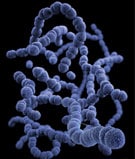Key points
- Bacterial conjunctivitis (pink eye) is very contagious and caused by many types of bacteria, including staph and strep.
- Signs and symptoms of bacterial conjunctivitis overlap with other causes of conjunctivitis, which can make diagnosis difficult.

Acute bacterial conjunctivitis
- What: Most common form of bacterial conjunctivitis.
- Cause: In children is often caused by Haemophilus influenzae, Streptococcus pneumoniae, or Moraxella catarrhalis.
- Therapy: Typically self-limited within 1 to 2 weeks, but topical antibiotic therapy may reduce the duration of disease.
Hyperacute bacterial conjunctivitis
- What: A very rare and severe type of conjunctivitis with rapid onset and progression.
- Severe symptoms: massive exudate, severe chemosis, eyelid swelling, marked hyperemia, pain, and decreased vision. Can progress to corneal infiltrates, melting and perforation, and vision loss if not treated promptly by an ophthalmologist.
- Cause: Neisseria gonorrhoeae or Neisseria meningitidis.
- Therapy: Requires both parenteral and topical antibiotic therapy.
Chronic bacterial conjunctivitis
- What: Defined as symptoms lasting for at least 4 weeks. People with this condition should see an ophthalmologist.
- Cause: Staphylococcus aureus or Moraxella lacunata.
- Symptoms: Often occurs with blepharitis (inflammation of the eyelid), which can cause flaky debris and warmth along the lid.
Chlamydia trachomatis
In neonates
- Infection usually is acquired during delivery of infants born to mothers with Chlamydia trachomatis.
- It is called chlamydial ophthalmia neonatorum in the first 4 weeks of life.
- Symptoms usually develop 5 to 14 days after birth; symptoms can develop earlier if the amniotic sac is ruptured during delivery Concurrent chlamydial infection elsewhere in their bodies (e.g., lungs, nasopharynx) is common.
- Approximately 50% of infants who develop pneumonia have a history of chlamydial conjunctivitis.
- Presenting symptoms include watery, mucopurulent, or bloody discharge, marked swelling with red, thickened, and friable conjunctivae, and a pseudomembrane may form.
Among sexually active people
- Acute disease is commonly unilateral with hyperemia and purulent discharge and caused by Chlamydia trachomatis subtypes D through K.
- Many patients will have a mild prolonged course.
- Presenting with chlamydial conjunctivitis will have an associated genital infection.
Causes trachoma
- The leading global cause of preventable blindness.
- A chronic follicular conjunctivitis caused by Chlamydia trachomatis subtypes A through C.
- Scarring of the inner eyelid which can cause the eyelashes to turn in and scratch the cornea (trichiasis), leading to permanent damage.
- Transmitted from person to person through contact with discharge from the eyes or nose of an infected person, through shared items, or by flies spreading ocular secretions.
- Repeat infections occur in children younger than 10 years of age.
- Common in developing countries where access to water and sanitation may be poor.
- The World Health Organization established the public health strategy known as SAFE which combines surgery to correct trichiasis, antibiotics to clear infection, and prevention measures to keep the disease from spreading.
Keep Reading:
Trachoma and other hygiene-related diseases
